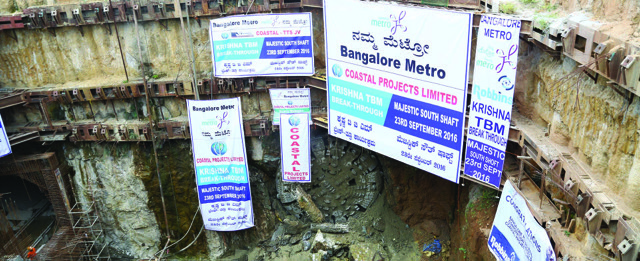On September 23, 2016, Bangalore’s last
TBM for the city’s metro rail project broke through, marking the end of TBM
tunneling on the Namma Metro phase 1.
The Robbins-operated machine, known as “Krishna”, bored a 750 m (2,460
ft) drive through challenging conditions between Chickpet and Majestic
stations. Cleanup and final
commissioning of the tunnel will be completed in 2017, and is the last obstacle
before owner Bangalore Metro Rail Corporation Ltd. (BMRCL) can open the
Malleswaram-Majestic link. The TBM’s sister machine, “Kaveri”, completed a
parallel tunnel in June 2016.
The success follows a gauntlet of challenges
on the two tunnel sites. Due to severe delays on the original tunnel drives,
Robbins was approached and asked to take over the operations of the remaining
two competitor-manufactured TBMs in February 2015. After obtaining agreement
from the project owner and the contractor, Robbins took over the responsibility
for all aspects of the underground operations. “We provided a team of over 60
staff including TBM operators, TBM technicians, ring builders, a grouting team,
and more. We were also responsible for running surface installations and
equipment such as the grout batching plant, gantry cranes and power supply.
Contractor Coastal Projects Ltd. (CPL) provided a team of people including
surveyors, QC engineers, and loco operators who reported directly to our site
management team,” explained Jim Clark, Projects Manager for Robbins India.
The Robbins crew carried out tunneling
operations while the Chickpet station was being constructed around them to
mitigate delays incurred before they took over project operations. The
project’s most difficult challenges included a low overburden and
unconsolidated ground along the alignment, and the discovery of several
uncharted wells directly on the alignment. Difficult ground frequently
prevented proper pressurization during cutting tool replacement, requiring a
grout solution to be pumped in to fill voids and left to cure. Initially the curing process took up to 36
hours, but with improved application methods this was reduced to a 12-hour
curing time.
Another challenge involved the
sensitive building structures along the tunnel path. Issues with surface
vibration, explained Clark, required that cutterhead speed be limited to 1.8
RPM during the day shift and 1.2 RPM during the night shift. Despite the
obstacles, the TBMs advanced at rates of up to 50mm (2 in)/min in highly
weathered rock.
“This is an industry first, wherein a
TBM manufacturer has utilized their in-house expertise and knowledge to take on
this level of responsibility for a project,” said Clark, addressing the
magnitude of the successful breakthroughs. “The fact that it was ‘a first’ and
we were successful in bringing this high-profile project back on track is a
great achievement for The Robbins Company.”
Now that tunneling is complete, the
North and South runs of the Namma metro will be connected--a line that, once in
service, will carry an estimated 40,000 passengers daily. It is anticipated
that Phase One of the metro will be opened in its entirety in 2017. 42/16


